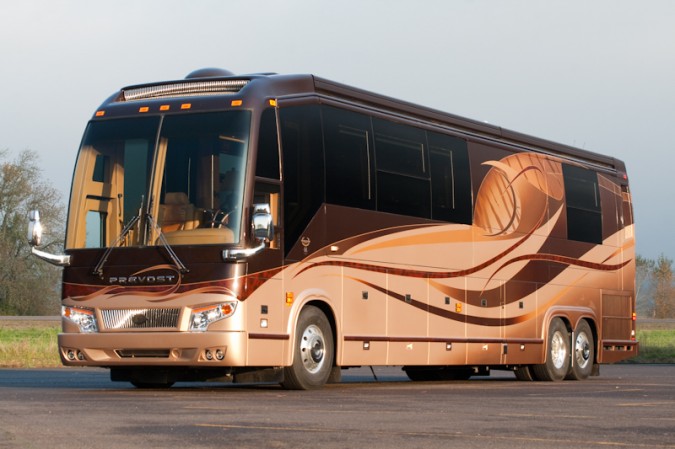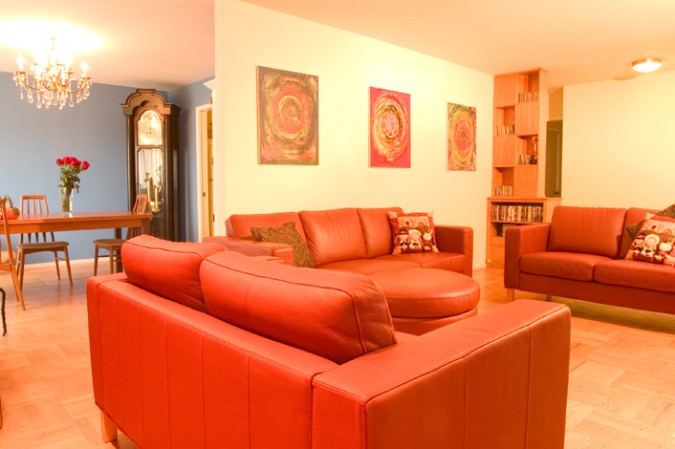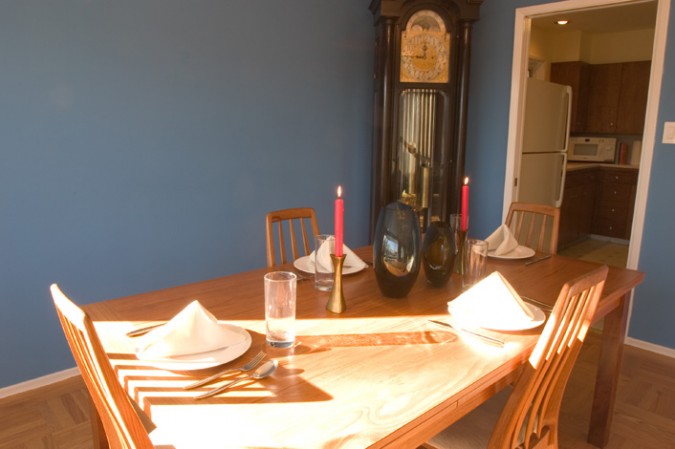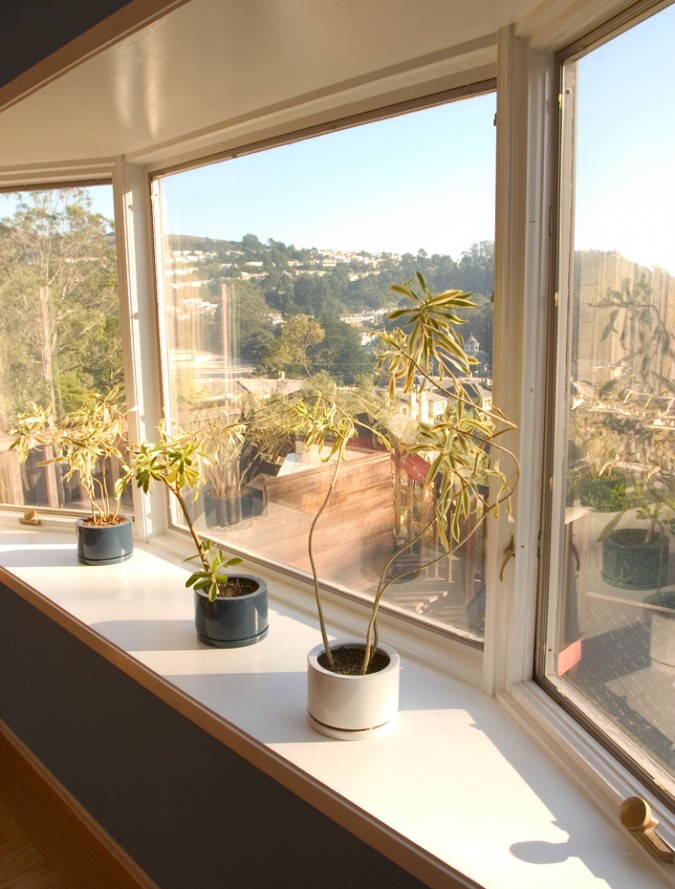Archive for 2011
Kevin Warnock’s Plan To Efficiently Air Condition a Bus Conversion

Marathon Coach bus conversion. This is not Kevin's conversion, but a finished professional conversion that costs over USD $1,000,000.00. This is to give you a rough idea what the plan is, though Kevin's will be much less fancy but more more green. It will also cost much, much less to own, complete and operate.
I’ve touched on my bus conversion project before. Today I will start writing about it in more detail.
The bus is a 1994 TMC 80206 “RTS”. The engine is a Detroit Diesel Series 50 rated at 275 horsepower. There are but 4 cylinders, down from 6 or 8 in most large buses. Fewer cylinders often mean better milage, just like with cars. This bus gets 11 miles per gallon on the freeway, which is outstanding for a vehicle that weighs so much and pushes so much air out of the way.
When I bought the bus in 2007, my plan was to do a quick conversion to a motorhome and then go on a six month tour of the United States with my girlfriend at the time. She hadn’t yet graduated from university, so there was time to finish a rudimentary conversion. She wanted to take a break after graduation and before starting her career, but sadly, she got offered a great job at Stanford University that she had to accept, since it came through a family introduction. She was most unhappy about not getting to take a break, and I was too, as she never had another break from full time work, and now we’re no longer together. That we never got to take the bus out for even one night really breaks my heart.
Life goes on, and there will be new girlfriends and I hope, another marriage, and, I hope, children.
My enthusiasm for the bus is still strong, and I will finish the project and use the conversion. I’ve invested too much to just sell off the partially finished project, and I would get next to nothing if I sold it today anyway.
Since this is a blog post and not a book, I will focus on just a small part of the project today, the air conditioning system.
Most bus conversions handle air conditioning while parked by installing a large diesel generator, in the 5,000 to 15,000 watt range, and use the power to run 2, 3, 4 or even 5 powerful yet not efficient air conditioners at once, to cool the entire interior simultaneously. Owners that live in hot regions have to run the generator and the air conditioners 24 hours a day for the duration of their travels, it can be that hot out. When I drove my first bus conversion across the United States from California to New York in 2002, I typically ran my 6,500 watt generator from morning until bedtime, which cost me about $20 a day in gasoline, and gas was much cheaper back then. It would simply not be cost effective to build a new conversion that uses so much fuel just to stay cool inside. So I have in mind something better, which I will write about here.
I have in mind covering about more than half the roof with 10 250 watt photovoltaic solar panels. These will cost about USD $7,000. In full sun, they will output 1,250 watts of power at 24 volts DC. Run through my Trace SW 4024 inverter, this is enough to power a 9,000 BTU mini-split air conditioner with a 20 SEER rating. This means the AC will draw about 450 watts of power at 120 volts.
9,000 BTU of cooling is not enough to cool a 40 foot bus conversion all at once, especially one with a full set of original side windows like mine has. The way I will handle this is to break up the inside into smaller zones. Right now there are three zones, the driver compartment, the living room and the bedroom. Eventually there will be one more zone, the guest bedroom, for 4 altogether.
I don’t need to occupy all the rooms at once, and I hate the noise that air conditioners make, so I have a plan to distribute the cool air from the one air conditioner to where it’s needed.
The plan borrows from the commercial air conditioning world, where cold water is used to cool rooms, as opposed to cold refrigerant, as is used in residential room air conditioners.
I plan to modify the inside portion of the mini-split air conditioner so that I submerse the evaporator plate, the part that gets freezing cold, in a large tank of water. This will cool that tank of water over time to about 35 degrees F. Then, I will use this cool water to pump through a distribution system of pipes in the ceiling of the bus to ‘heat exchangers’ in each room, or zone. Since cool air falls, these heat exchangers will be in the ceiling as well. Think of them as mini car radiators. Hot air in the room will pass over the cold fins and be cooled. The cool air will circulate down into the zone since cool air falls. The water inside the heat exchanger will pick up heat from the surrounding air. This heat will be carried back to the large water tank to be re-cooled by the mini-split evaporator that’s immersed in the tank. The mini-split will capture the heat from the water and send it outside the bus to the condensor part of the mini-split, which will be fan cooled on the exterior roof of the conversion.
The beauty of the above system, if it works, is that there won’t be any noisy fans inside the rooms. The inside part of the mini-split will probably be silent since the fan isn’t needed to push warm air over the evaporator. There may be a small noise made by the circulation water pump, but I suspect that it won’t be audible.
The heat exchangers should also be silent. It may turn out I will need a small fan near them to optimize their performance, but a quiet computer muffin fan or two should be sufficient.
Since the zones are fed by cold water in PEX plastic pipe, it should be easy to change which zone is being cooled by flipping regular water valves. No special certification is needed to install water piping, but installing copper tubing for AC refrigerant is not easy.
The final benefit of my proposed system is the sun can be used to cool the water tank during the day, but then the coldness of the tank can be ‘harvested’ at night to keep the sleeping zone cool throughout the night, without running a noisy and fossel fuel dependent generator. When I drove across the country in 2002, I hated to run the generator all night long, as even with ear plugs I could barely fall asleep it was so noisy.
When I add the 4th zone, the master bedroom will be tiny, at about 50 square feet by 4 feet high, or 200 cubic feet. I will have removable 3 inch thick insulating window panels I can press into the window openings to really insulate the compartment. The bedroom door will be weather stripped and insulated, perhaps itself 3″ thick. This will mean that the water tank is not trying to cool a particularly large area. With a 24 volt celiing fan circulating air over a heat exchanger, I think I will have found an essentially silent and free nighttime air conditioner for touring the world in hot weather.
I would love to use ceiling fans in the other zones, but sadly there is not enough ceiling height except over the bed to install a full size ceiling fan.
I can’t take credit for the idea above to dismantle an air conditioner and submerse the evaporator plate in a tank of water. This is routinely done by indoor gardeners trying to use liquid cooling to cool powerful grow lights. They take apart a $100 window air conditioners and bend the copper piping to the evaporator plate to dangle it in a tank of water. Once this water is cooled, it’s piped into the grow light fixtures themselves, which often draw a lot of power and so get very hot. The hot water from the fixtures is piped back to the water tank, where the window air conditioner again cools the water for the next cycle. i found videos online demonstrating the technique. I won’t link to them since these indoor growers appear to be growing illicit crops, which I frown on and have nothing to do with. But I do admire the ingenuity of the growers, and I thank them for helping me formulate my above plans.
While doing my research on this system, I found a venture backed company doing something similar to what I propose, but for commercial installations. They use relatively cheaper grid electricity during the night to freeze a multi hundred gallon tank of water, and during the hot day they melt that block of ice to cool the building. This is clever because grid electricity rates are much lower at night, when the grid is relatively lightly loaded. The company has products installed, and it looks good. I don’t plan to go all the way to ice because that would require something other than a cheap mini-split air conditioner, and I want to keep this system cheap and built from off the shelf commodity parts so it can be repaired anywhere should it malfunction. Also, mini-split air conditioners are available in very high efficiency models, such as 20 SEER. This is an astonishingly high number compared to the non-regulated rooftop RV air conditioners most bus conversions use, which can be around 10 SEER. Going from 10 to 20 in SEER cuts the power used in half, which is a really big deal when you have limited roof space for solar panels, and the panels cost a fortune for enough of them to run even one moderate sized air conditioner.
During the day, I would just cool the living room, of course. I have sliding shades on the windows, and silver reflective mirror on the outside of the glass, which cuts dramatically the heat infiltration through the windows. I also plan to make some 3″ thick removable panels I can press into the window opening to really insulate the windows I don’t need to be transparent. I suspect it would be much more energy efficient in fact to block all 6 windows in the living room and turn on my compact flourescent lights during the day, rather than to leave one or more windows unblocked. The living room is separate from the driver’s compartment, which is full of air leaks due to the transit bus front door, which can’t effectively be sealed. The door between the living room and the driver’s compartment will be insulated and weather stripped. I’ve often wondered why doors are so thin. The walls are often six inches thick but the doors are 1 3/4″ thick. Why not make the doors also 6 inches thick, filled with high density closed cell foam, similar to a SIP panel for house construction? This would require a new type of door knob and lock, but that is an opportunity to sell more expensive hinges and door hardware. I think thick doors should be required by code for all construction, residential and commercial, interior and exterior. Thick interior doors would cut sound transmission and make it easier to implement zones in buildings. The current practice of heating an entire home when the occupants are often in just one room needs to cease. Each room should be insulated from the others, and there should be a way to temper each room individually. How about the idea of having a switch similar to a light switch in each room? To be effective, each room will probably need two parallel systems – one quick reacting and one slow reacting but more efficient over the long time. I have such a system in my bedroom in my house. I have a 400 watt panel heater that contains no fan and thus takes hours to warm up the room. I also have a forced air wall heater that can heat up the room in a few minutes. When I enter the room and it’s freezing, I turn on both heaters, and then turn off the forced air heater after a few minutes. Then the slower acting convection panel heater takes over maintaining the temperature indefinitely. What could work perhaps would be hydronic floor water heating plus a forced air unit for rapid heating. It might even be that both heating systems could be hot water based, with a large heat exchanger mated with a powerful fan for rapid heating, and in floor piping for maintenance heating. I’m quite serious about this scenario, and I can see it being the dominant style of heating worldwide 100 years from now, with the water heated exclusively by solar hot water heating panels.
I can’t promise all my bus conversion posts will be this long, as this took some real effort to write. Please write me a comment if you like or dislike it. I would love to get a discussion going in the comments about the pros and cons of my ideas presented here.
I discovered the box in the upper right to subscribe to this blog has been broken for some time, so I don’t have as many subscribers as I otherwise would have. If you liked this post, and would like to subscribe, please type in your email address in the little box in the upper right. I won’t write useless nonsense to you, I promise. Thank you.
Housemates wanted for urban homesteading in San Francisco
I’ve written here about my plan to start urban homesteading at my San Francisco home. I’ve got an ad running now on Craigslist.org, and I’ve met some fascinating people who’ve responded. Since the ad will come down once the house if full, and since I’m proud of the ad, I’m posting it here for posterity, and to make it easy to find the next time there’s a vacancy. Here’s the ad, in its entirety. Note that on Craigslist the pictures are located at the bottom, and are small. For this post, I interspersed the photos with the text, and made them larger.
Hello,
I started shopping at Rainbow Grocery on Folsom Street around the start of this year. Rainbow is an entirely organic, vegetarian coop, and it changed my life. I’ve lost 30 pounds without trying, and am back to the weight I was in college.
I started on this path after reading Omnivore’s Dilemma by Michael Pollan, the famed New York Times writer turned author. This book changed my life more than any other book, as it changed how I eat and how I feel, as a result of eating better. I’ve gone on to read lots more books about sustainable, healthy eating and living, including Farm City, by Noella Carpenter. She used the vacant lot behind her gritty Oakland apartment to start a community vegetable garden. Eventually, she began raising ducks, chickens and even two full size pigs. The book is fascinating and heartwarming and really moving.
That leads me to this advertisement. I want to turn my huge backyard (nearly a quarter city block in size) into a city oasis of farming. My backyard is on a South facing hill near UCSF and Golden Gate Park, so it’s in the path of sunlight all day. It’s already partly terraced. Here’s what I envision:
Renting out my three spare bedrooms to people interested in making an inviting home that takes daily advantage of the bounty I’m confident my yard can produce. I want to try my hand at so-called ‘urban homesteading’, but I don’t want to do it by myself. So I’m looking for likeminded people to participate.
I’m a good cook too, and love having dinner parties. I’m hoping that once I put this household together that we have group roommate dinners a couple of days a week, with everyone pitching in to make them fun.
Here’s a list of what I hope to have us do together in the big backyard:
1. Grow vegetables and fruit trees in the dirt
2. Set up a green house and practice so-called ‘aquaponics’ which is where fish and vegetables are grown in close symbiosis. A tank of fish contains a lot of fish poop, and the tank water is used to flood a grow bed of vegetables mounted over the tank. The roots of the vegetables draw up the fish poop and cleanse the water in the process. The newly clean water is released back into the fish tank, in a cycle that repeats 24 hours a day via a pump and timer. The vegetables grow 600% faster than in dirt, and the fish grow 200% faster than in the wild. Both the fish and the vegetables can be consumed. There are few weeds to deal with as the vegetables grow in a gravel base, not dirt, so there are no stray weed seeds in the soil to contend with. The fish are safer than wild fish since there is less chance of them encountering pollution. I have the equipment to set this up, but it’s not set up yet, so I haven’t tried it yet. I’ve read enough about it that I’m convinced it will work. High end restaurants in New York City get their produce from barges on the Hudson Bay that grow on board using aquaponics. The technology dates back thousands of years I’ve read.
3. Raise chickens.
4. Raise ducks.
5. Raise and milk two miniature dairy goats. Goat milk tastes better than cow’s milk, but at $16 a gallon at Rainbow Grocery, it’s too expensive for daily drinking. Having my own goats will help solve that problem.
I am not a vegetarian, but I don’t buy industrial meat. I shop at a local butcher shop and eat only grass-fed beef and well treated chickens. Yes, this costs twice as much as industrial meat, at a minimum, but the taste is better and I feel much better about it. Micheal Pollan’s description of what happens to industrially raised livestock is so disturbing that I haven’t bought any industrial meat at a grocery store since I read his book.
My last three housemates, who just moved out, were all vegetarians, so I don’t object to vegetarian housemates at all. I eat little meat, just a few ounces per main dish. I definitely don’t cook steaks or ribs or hamburgers. I do put meat in the great Chinese and Indian dishes I cook up. I’m a good vegetarian cook as well, since I did the cooking for the household group meals we have had here.
If you’ve read this far, you’re probably wondering what the rooms for rent are like. The smallest room is 10’ x 11’ and I’m asking $775/mo. The middle sized room is 10’ x 12’ and I’m asking $825/mo. The master bedroom is 11’ x 15’ and has its own full bathroom. I’m asking $995/mo for this room.
There is a large furnished living room, a dining room and kitchen. There is also a 12’ x 12’ food redwood deck off the living room, and this deck is on the second floor, so the view is particularly spectacular. There is a water spigot and electrical outlet on the deck, and there’s a tiled workspace and a charcoal Weber grill.
I’m an entrepreneur by profession, in the dot com world. I like having the house full of interesting people, which is what has me so interested in this project. I have a strong interest in the environment and my dream is to start a company manufacturing homes so green that they don’t need to be connected to the grid, but if they are they could send excess power back to the grid. In furtherance of this dream, I’m building a demonstration eco-home to test some of the super energy saving ideas I’ve read about, including a green aquaponics roof system.
Sadly, my house is not particularly green yet, so utilities historically have come to $75/mo per person when there are four people living here. I have the records on a spreadsheet to demonstrate this.
The house has a 6 meg per second DSL WiFi connection. There are cable TV, Ethernet and phone jacks and separately adjustable wall heaters in each bedroom. There is a real wood burning fireplace in the living room.
I’m looking for housemates that WANT to garden, experiment, raise livestock and share group household meals. You don’t need to have experience doing these things. I don’t have much experience gardening, but I can do anything I put my mind to, so I have no fear. I hope you’ll pitch in with taking care of the animals, since goats will stop producing milk if they are not milked everyday. I can’t keep up that schedule personally, since I sometimes travel for work and pleasure. But I’ll do my fair share and more, happily. I think this group household idea holds real merit, and that we’ll all benefit in many unforeseen ways from helping each other out. Our food bills should decline, and our food quality should go up. If you can’t see milking a goat, that’s OK. I’m sure some people will be able to help, and I don’t think the goats need four people to milk them daily. Even if I just find one housemate capable of milking the goats, that will be enough. Note that San Francisco permits chickens, ducks and miniature goats provided there’s space, and I have the space, so we don’t have to sneak around to do this project. Even so, we’ll be neat and considerate, since there are neighbors, who I’m good friends with.
I would expect you to help buy gardening supplies. I’ll provide the capital for things like setting up the aquaponics system and green house. But I can’t commit to buying all the consumables if I’m sharing three-quarters of the results… I hope you understand.
I’m not proposing getting free labor from my housemates. I’m proposing that we work together to take advantage of the huge backyard that’s sitting idle right in the center of San Francisco for the benefit of all of us. This is San Francisco and I’m sure there are hundreds of people who share my ideals of clean, green and self-sufficient living, but can’t do too much living in an apartment. I have enough space here we might be able to grow enough food to entirely live on. I don’t know for sure, but I suspect we could.
If you have an interest in raising bees that would be particularly great. I am someone afraid of bees so I don’t think I’ll pitch in on that project, but I LOVE the concept and I love honey, so I would be very supportive.
The rooms are all available immediately. I am willing to rent on a month-to-month basis, but I prefer that you have in mind to stay a while since it’s hard work finding compatible roommates. But since this situation is more collaborative than most shared housing situations, I recognize things could not work out, so I won’t try to tie anyone down with a term longer than a month.
I’m pretty clean, and so were my past housemates. We kept the common areas clean, and didn’t let dishes sit in the sink. Our rooms were a different story though, and I expect and am fine with rooms getting somewhat out of control. But that doesn’t mean you can leave pizza boxes around your room either… lol
Sorry, but this house doesn’t allow any smoking, inside or outside. There is a huge forest of eucalyptus trees in the backyard, and if they were to catch fire, the whole hillside would explode in flames. Also, please, no drug use or excessive alcohol use. While I want a group household with shared interests in eco interests, I don’t want a house of drug using partiers. I’m easy to get along with, and my roommates told me they loved living here. So I’m looking for kind, respectful and non-irritable people to share this special San Francisco oasis with.
To apply, please write a few paragraphs introducing yourself. In particular, please describe why you are interested in this shared housing situation, to make me certain you didn’t copy and paste your reply and actually read this ad carefully.
The three roommates who just moved out were all female. It was a totally cool vibe in the house. I’m a straight guy in my 40s. I’m open to both men and women living here, in whatever combination naturally happens. My past housemates were in their 20s and 30s, so if you’re younger, please don’t ignore this ad because I’m older. I’m definitely young in spirit, and I’ve got some fun, approachable hobbies. I’m a photographer and painter, for example.
The 36 MUNI bus stops right in front of the house, and there is plenty of free, unlimited time street parking by the house. You’ll rarely have to walk more than a 1/4 block from your car if you drive. It’s a 15 minute walk to the 9th Avenue and Irving Street shops, restaurants and bars.
I write a blog at http://kevinwarnock.com where you can learn more about me and my interests. You can see the website I made for the house, with big pictures, at http://sanfranciscohouseforrent.com
I’ve never tried to put together such a collaborative household before, so I don’t know what to expect. But I’ve thought about this for a long, long time, so I’m definitely motivated to make this work. I look forward to your thoughtful replies.
Warm regards,
Kevin
———————————–
I discovered the box in the upper right to subscribe to this blog has been broken for some time, so I don’t have as many subscribers as I otherwise would have. If you liked this post, and would like to subscribe, please type in your email address in the little box in the upper right. I won’t write useless nonsense to you, I promise. Thank you.
I am going to teach people I don’t know to cook

Pan with fruits and vegetables. Photo by Michael Korcuska via Flickr, used with Creative Commons commercial use license
I love to cook. I love to eat. I love technology. I love photography. My camera shoots high quality video. I like visitors to my blog.
Given the above, I’m going to start an online cooking show. I have been talking about this for years now, but this year I’m going to take action and get started.
I have access to a dedicated studio just for this project, and it’s all new and sparkling clean. It’s not someones’ kitchen – it’s dedicated to this cooking show and has in fact never been used for cooking, as that would put wear and tear on the appliances and cabinets and decor, and shorten the time everything looks brand new. It’s not quite finished yet, but soon will be. Light fixtures with properly color balanced bulbs for professional results have been acquired, and test shoots have been completed. The space looks amazing on video.
I’m going to use my Canon 5D Mark II camera to shoot the video. This is an astonishingly good video camera, as you can see from the video I’ve already posted to this blog. I will edit the video myself in Apple’s iMovie software.
I’m ordering a dedicated wok burner, since I plan to start the episodes with dishes that are cooked in a wok.
I have in mind that I’ll take the viewer shopping with me to Rainbow Grocery coop, where I do my own grocery shopping. This is the best grocery store I know of, and it’s a model for how I think the world’s grocery stores should be run. One of the best things about it is the stunning variety of offerings, and the large bulk goods section. This section contains some 800 items. I take a dozen Ball brand glass caning jars with me shopping and fill the jars directly from the bulk bins. As a result, I throw out very little in the way of packaging each week since I reuse my glass jars indefinitely. I am paid a nickel for each jar I reuse, which is a powerful incentive to avoid wasting packaging. I would increase the incentive to 25 cents for better compliance, as it’s currently quite low from what I observe in line at the checkout stand.
I want my cooking show to teach people how to cook. But I also want to introduce people to different, more efficient ways to organize commerce so that these ideas can be copied and spread.
I’ve never taken a cooking class, so I technically don’t know if what I think I know is ‘correct.’ But what I cook tastes good, and is different from Panda Express and most Asian restaurants. I like to think it’s as rewarding as what you would buy in a modest but not cheap Asian restaurant. I think that’s pretty good given I’ve only been at this a few years and haven’t taken any classes. I hope to get a discussion forum going so that I can learn from my more educated viewers that might be so kind as to correct my mistakes.

Soup, picture by Flickr user avlxyz. Used by Creative Commons commercial license granted via Flickr.
I also plan to show viewers my garden and aquaponics system I’m setting up now. I will cook from the garden as soon as possible.
I hope to develop a speaking style that permits me to inject social commentary into the lessons, in a way that’s not overbearing or that comes across as lecturing. I really want to impress on my viewers the importance of not eating out much, both for biological health and financial health reasons.
I passionately believe that cooking should again be taught in middle school and high school. Eating is universal, so everyone should be taught how to cook. It’s a tragedy I didn’t really learn to cook anything exciting until 2006.
If I get a good viewership on Vimeo and YouTube, I hope to take my show to public access television.
I recognize that the big celebrity chefs one sees on TV have devoted their lives to their craft. I have no plans to make this my life, so my show may well be awful compared to what the pros are doing. But I don’t think it will be awful. I think it will be approachable, educational and warm hearted, and that it will touch enough people to make it well worth my time. Look for the first episode by February, 2011.
Note that I went to school with an actual TV chef, but I haven’t seen him since I was 14. If he should ever stumble upon my show, I hope he is kind should he bump into me at a future high school reunion. I only know about his TV life because of Facebook, not because I’ve seen him on television…
The craziest thing about my plan is I don’t watch cooking shows and don’t own a functioning television. I didn’t even know who Emeril was until 2008.
I wonder if Julia Child boxed sets are available on DVD or Netflix on demand?
I discovered the box in the upper right to subscribe to this blog has been broken for some time, so I don’t have as many subscribers as I otherwise would have. If you liked this post, and would like to subscribe, please type in your email address in the little box in the upper right. I won’t write useless nonsense to you, I promise. Thank you.
Kevin Warnock’s Plans For 2011
This year is going to be different from the last ten years.
I view the last ten years as my ‘lost decade.’ I sold my first Internet company in 2000, and haven’t had a big success since. Yes, I invented the online office suite with gOffice.com in 2004 and got married in 2008, but I should have gotten more done in 10 years.
It’s time to reinvent my life and create a new path for myself.
Part of my plan is to dramatically expand my circle of friends and acquaintances. I am somewhat shy by nature, but I’ve gotten much less shy in recent years. I credit my wife with that because she is outgoing, and that rubbed off on me. I’m much more likely today to start up a conversation on the subway or in the grocery store line or at the library than even two years ago. I can even give my card to total strangers that I’d like to photograph. I was always scared to approach subjects, but once I started doing so, the reactions were great and it was easy and even fun. What was I so scared of?
I’d like to make friends with interesting people who are doing interesting things. In addition to meeting people in person, I view this blog as a conduit to meet the kind of people I’d like to make friends with. I’m going to do that by starting to write more frequently on more subjects, and see how that goes. So, if you read something here that strikes a chord with you and you think we’d have something in common, please send me a comment or email.
In no particular order, here’s a quick list of some of the accomplishments I hope to achieve in 2011:
- Sell my old bus conversion. It’s a 1967 MCI 5a. I drove it in 2002 to New York City and back from San Francisco, so it’s road worthy and reliable. It’s fun to drive and has a lot of character.
- Establish a vibrant household with interesting roommates where we grow our own vegetables and fish and cook together twice a week. See a description of the house and what I have in mind at SanFranciscoHouseForRent.com.
- Finish my new bus conversion to a degree where I can use it for travels. It’s a 1994 “RTS” that gets outstanding mileage and looks great. There’s a lot to do, and I’m looking for bus nuts to get involved in the project. Read about bus conversions at one of my favorite web sites BusConversions.com
- Learn more of C# so I can accept a wider variety of programming work. I am now a VB.NET developer primarily, but sadly this language is decidedly uncool, even though it still works great.
- Continue my programming consulting practice at Silveroffice, Inc., and increase my customer base.
- Install new rain gutters on my house.
- Replace my car with a diesel model I can fuel with biodiesel.
- Start to establish myself as a writer and public speaker about green homes and sustainable living. This is a big goal, and one I hope I make real progress on. I am passionate about this subject, as you will see in future posts.
- Years after graduating from Brooks Institute, make money at least six times this year selling my services as a photographer. I specialize in photographing people, either alone or in groups. I’m particularly good with couples, and I pride myself on making people feel comfortable, even if they’ve never been photographed by a photographer before. You can see my work at my photography website photography.KevinWarnock.com.
This list will keep me plenty busy. Remind me to post a follow up on December 31st, 2011 if I should forget…
Financially Stupid People Are Everywhere – Don’t Be One Of Them
Yesterday was New Years Eve – a fitting time to finish reading a good book by Jason Kelly – Financially Stupid People Are Everywhere, Don’t Be One Of Them. This book hammers home the notion that most people are stupid about money and need to radically change their view towards it and approach to getting and making most valuable use of it. I have made plenty of mistakes with money, for which I am embarrassed and not proud. Had I read and followed the advice in this book when I sold Hotpaper.com, Inc. and made a substantial pot of money, I might now have several times that pot of money. Instead I have less than all of it remaining, which Kelly would frown on I’m sure.
Jason Kelly uses blunt, provocative language to make his points. It’s unlike any financial book I’ve yet read. The message of the book is that the system is designed from every angle to quickly and completely separate people from their money, and that one must forever change behavior if one is to avoid having their money drained.
There is no particular great wisdom in this book, but even so it’s a good book and worth reading. In particular, people with lots of debt, little savings and little hope should run to the library and check out this book and read it in a day or two. It’s a quick read, and hard to put down. I have already adopted many of the suggestions in the book like paying cash for my vehicles and not carrying any balance on credit cards. But I still have a long way to go before Jason would give me a clean financial bill of health.
It’s the first day of 2001 today, so it seemed fitting to write about a book that has more potential to unshackle millions from their debt induced indentured servitude than any other single book I’ve read. Highly recommended.






